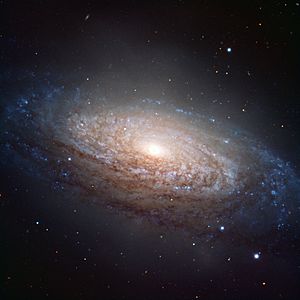NGC 3521 facts for kids

NGC 3521 is a beautiful spiral galaxy located in the constellation of Leo. It is quite far away from Earth, about 26 million light-years from us. This galaxy is known for its unique, fluffy-looking spiral arms, which makes it a special type called a "flocculent" spiral galaxy.
Contents
What is NGC 3521?
NGC 3521 is a galaxy, which is a huge group of stars, gas, and dust held together by gravity. Our own Milky Way is also a galaxy! NGC 3521 is classified as an intermediate spiral galaxy. This means its spiral arms are not tightly wound like some galaxies, nor are they very loose.
A Spiral Galaxy
Imagine a giant pinwheel spinning in space – that's what a spiral galaxy looks like! They have a bright central bulge and arms that swirl outwards. These arms are where many new stars are born. NGC 3521 has a slightly fuzzy or "flocculent" look to its arms, meaning they are not smooth and clear but rather patchy and clumpy.
What is a Light-Year?
When we say NGC 3521 is 26 million light-years away, it means the light we see from it today started its journey 26 million years ago! A light-year is the distance light travels in one year. Light moves incredibly fast, about 300,000 kilometers (186,000 miles) per second. So, 26 million light-years is an enormous distance!
Finding NGC 3521
NGC 3521 is found in the constellation Leo, which is Latin for "the Lion." Constellations are patterns of stars that people on Earth have imagined in the night sky. You can see Leo in the spring sky in the Northern Hemisphere. Finding NGC 3521 within Leo requires a good telescope because it's not visible to the naked eye.
How Galaxies are Discovered
NGC 3521 was first discovered by a famous astronomer named William Herschel in 1784. He used a telescope to scan the night sky, carefully noting down new objects he found. Many galaxies and other celestial bodies are named using "NGC" numbers, which stands for "New General Catalogue," a list of deep-sky objects created in the late 1800s.
Observing NGC 3521
Astronomers use powerful telescopes to study galaxies like NGC 3521. These telescopes can collect light from very far away objects, allowing us to see details that would otherwise be invisible. The image of NGC 3521 you see was taken by the Very Large Telescope, or VLT, which is one of the most advanced telescopes in the world.
The Very Large Telescope
The Very Large Telescope (VLT) is located in Chile, South America, high up in the Atacama Desert. It's not just one telescope, but four large telescopes that can work together to create incredibly detailed images of space. The VLT helps scientists learn more about how galaxies form, how stars are born, and what the universe is made of. Studying galaxies like NGC 3521 helps us understand our place in the vast cosmos.
See also
 In Spanish: NGC 3521 para niños
In Spanish: NGC 3521 para niños

